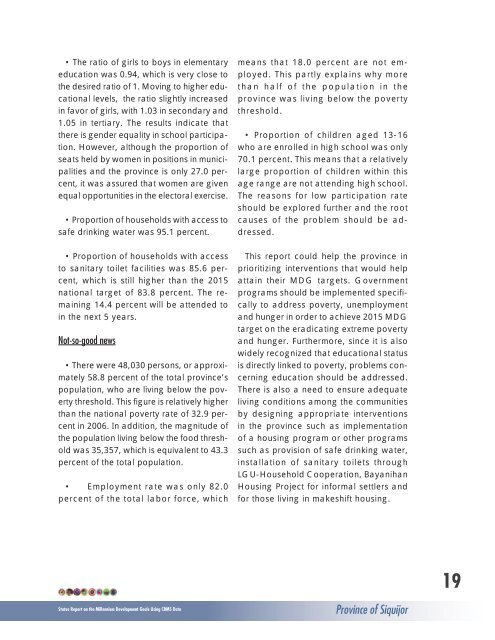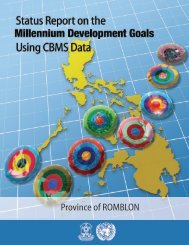Province of Siquijor - UNDP in the Philippines
Province of Siquijor - UNDP in the Philippines
Province of Siquijor - UNDP in the Philippines
Create successful ePaper yourself
Turn your PDF publications into a flip-book with our unique Google optimized e-Paper software.
• The ratio <strong>of</strong> girls to boys <strong>in</strong> elementary<br />
education was 0.94, which is very close to<br />
<strong>the</strong> desired ratio <strong>of</strong> 1. Mov<strong>in</strong>g to higher educational<br />
levels, <strong>the</strong> ratio slightly <strong>in</strong>creased<br />
<strong>in</strong> favor <strong>of</strong> girls, with 1.03 <strong>in</strong> secondary and<br />
1.05 <strong>in</strong> tertiary. The results <strong>in</strong>dicate that<br />
<strong>the</strong>re is gender equality <strong>in</strong> school participation.<br />
However, although <strong>the</strong> proportion <strong>of</strong><br />
seats held by women <strong>in</strong> positions <strong>in</strong> municipalities<br />
and <strong>the</strong> prov<strong>in</strong>ce is only 27.0 percent,<br />
it was assured that women are given<br />
equal opportunities <strong>in</strong> <strong>the</strong> electoral exercise.<br />
• Proportion <strong>of</strong> households with access to<br />
safe dr<strong>in</strong>k<strong>in</strong>g water was 95.1 percent.<br />
• Proportion <strong>of</strong> households with access<br />
to sanitary toilet facilities was 85.6 percent,<br />
which is still higher than <strong>the</strong> 2015<br />
national target <strong>of</strong> 83.8 percent. The rema<strong>in</strong><strong>in</strong>g<br />
14.4 percent will be attended to<br />
<strong>in</strong> <strong>the</strong> next 5 years.<br />
Not-so-good news<br />
• There were 48,030 persons, or approximately<br />
58.8 percent <strong>of</strong> <strong>the</strong> total prov<strong>in</strong>ce’s<br />
population, who are liv<strong>in</strong>g below <strong>the</strong> poverty<br />
threshold. This figure is relatively higher<br />
than <strong>the</strong> national poverty rate <strong>of</strong> 32.9 percent<br />
<strong>in</strong> 2006. In addition, <strong>the</strong> magnitude <strong>of</strong><br />
<strong>the</strong> population liv<strong>in</strong>g below <strong>the</strong> food threshold<br />
was 35,357, which is equivalent to 43.3<br />
percent <strong>of</strong> <strong>the</strong> total population.<br />
• Employment rate was only 82.0<br />
percent <strong>of</strong> <strong>the</strong> total labor force, which<br />
means that 18.0 percent are not employed.<br />
This partly expla<strong>in</strong>s why more<br />
than half <strong>of</strong> <strong>the</strong> population <strong>in</strong> <strong>the</strong><br />
prov<strong>in</strong>ce was liv<strong>in</strong>g below <strong>the</strong> poverty<br />
threshold.<br />
• Proportion <strong>of</strong> children aged 13-16<br />
who are enrolled <strong>in</strong> high school was only<br />
70.1 percent. This means that a relatively<br />
large proportion <strong>of</strong> children with<strong>in</strong> this<br />
age range are not attend<strong>in</strong>g high school.<br />
The reasons for low participation rate<br />
should be explored fur<strong>the</strong>r and <strong>the</strong> root<br />
causes <strong>of</strong> <strong>the</strong> problem should be addressed.<br />
This report could help <strong>the</strong> prov<strong>in</strong>ce <strong>in</strong><br />
prioritiz<strong>in</strong>g <strong>in</strong>terventions that would help<br />
atta<strong>in</strong> <strong>the</strong>ir MDG targets. Government<br />
programs should be implemented specifically<br />
to address poverty, unemployment<br />
and hunger <strong>in</strong> order to achieve 2015 MDG<br />
target on <strong>the</strong> eradicat<strong>in</strong>g extreme poverty<br />
and hunger. Fur<strong>the</strong>rmore, s<strong>in</strong>ce it is also<br />
widely recognized that educational status<br />
is directly l<strong>in</strong>ked to poverty, problems concern<strong>in</strong>g<br />
education should be addressed.<br />
There is also a need to ensure adequate<br />
liv<strong>in</strong>g conditions among <strong>the</strong> communities<br />
by design<strong>in</strong>g appropriate <strong>in</strong>terventions<br />
<strong>in</strong> <strong>the</strong> prov<strong>in</strong>ce such as implementation<br />
<strong>of</strong> a hous<strong>in</strong>g program or o<strong>the</strong>r programs<br />
such as provision <strong>of</strong> safe dr<strong>in</strong>k<strong>in</strong>g water,<br />
<strong>in</strong>stallation <strong>of</strong> sanitary toilets through<br />
LGU-Household Cooperation, Bayanihan<br />
Hous<strong>in</strong>g Project for <strong>in</strong>formal settlers and<br />
for those liv<strong>in</strong>g <strong>in</strong> makeshift hous<strong>in</strong>g.<br />
Status Report on <strong>the</strong> Millennium Development Goals Us<strong>in</strong>g CBMS Data <strong>Prov<strong>in</strong>ce</strong> <strong>of</strong> <strong>Siquijor</strong><br />
19



